With the cost of pistol magazines, especially proprietary magazines, we often look for a break from the high cost. But, does that break in price really cost us in quality, construction, and reliability.
My word for the week is “vet” and I am about to vent my “vet” of the ProMag Springfield XDm Magazine .45 ACP 13 Rounds Steel Blued Finish SPR-A8. Then, you will be able to vet my vent about my vet of this vetted product.
Throughout my research of ProMag magazines, they have been presented to me as crap and should not be used under any circumstances. Now, there is crap and there is CRAP (Convincingly Reliable After Purchase). So, which one was it going to be?
The standard 13-round magazine provided (and sold separately) for the XD and XDM series of pistols cost about $30.00 (actual prices may vary according to where you can find them). The ProMag Springfield XDm Magazine .45 ACP 13 Rounds Steel Blued Finish SPR-A8 can be found for $14.97 through the Cheaper Than Dirt website. That is a substantial savings in cost, but at what expense?
As far as I can tell, ProMag is the only manufacturer that makes magazines for the 13-round, .45ACP version of the XD/XDM pistol.
I don’t know what the cost of dirt is these days, and I suppose that it depends on the quality and quantity of dirt, but if the dirt quality is poor it rarely matters how cheap it is. But then again, I suppose that it depends on what you are using the dirt for.
My search for the meaning of life continues as does the search for inexpensive, but quality, magazines for my packing pistols and for those that may be called up for duty whether duty is at the range or for personal defense. It is said that the weakest component of the semi-automatic pistol is the magazine, but I commonly refute that notion and lay the blame on the operator. Nonetheless, the magazine is a key operating component should be worthy of scrutiny by an unbiased third party such as myself. So, I felt it a worthy endeavor to purchase two ProMag Springfield XDM Magazine .45 ACP 13 Rounds Steel Blued Finish SPR-A8 magazines for the purpose of evaluating them and passing what information I garnered from the evaluation on to you.
From ProMag, we have the following information:
These magazines were designed for professional shooters and law enforcement personnel whose lives depend on a perfect shot every time. Expertly machined for exceptional quality and guaranteed to feed and function for every shot. ProMag magazines include a lifetime guarantee, if you ever have a problem with their magazines; simply return them to ProMag for replacement. When you need a cost effective aftermarket replacement mag that you know you can count on, you need a ProMag!
This magazine is made from Heat Treated Blued Steel with a base molded from TECHNAPOLYMER and an anti-fatigue steel spring for reliability.
The basic Specifications and Features are as follows:
- ProMag SPR-A8
- Springfield XDm
- .45 ACP
- 13 Rounds
- Steel
- Blued Finish
From here, I can move on to some critical, comparison information.
OUTWARD APPEARANCE:
Obviously, the outward appearance differs between the Springfield and ProMag magazines.
The Springfield magazine has a highly-polished appearance; whereas, the ProMag magazine appears to have a blued surface.
The cutout for the magazine catch appears to be in the same place on both magazines. However, the ProMag magazine has a hole slightly below the magazine catch point, and may serve as a drain hole, but other than that I have no idea of its purpose. A similar size hole is just above the base-plate of the ProMag magazine and, again, may serve as a drain hole.
The inspection holes, and round count numbers, in the Springfield magazine are at the rear of the magazine. The ProMag magazine has inspection holes in the left and right side of the magazine. Round count numbers are not included on the ProMag magazine.
CONSTRUCTION:
Springfield:
The Springfield magazine appears to be of chromed steel inside and out. I could not detect a seam where any sort of welding might have taken place. The witness holes are large and numbers are nicely stamped into the magazine for determining round count.
ProMag:
ProMag magazines are made from heat-treated high carbon steel and TIG welded for seamless weld. I could; however, detect fine remnants of the seam line on one of the two magazines that I received.
Witness holes are provided on each side of the magazine; however, round count numbers are not provided
MAGAZINE FOLLOWER:
The magazine followers on both magazines at first appear to be identical. However, the magazine follower of the ProMag sits higher than the follower in the Springfield magazine.
Taking a measurement of the feed lip spacing in both magazines revealed the following dimensions:
Feed Lip Spacing, ProMag = 11.04mm (0.34 inch)
Feed Lip Spacing, Springfield = 10.48mm (0.41 inch)
Feed Lip Cut Depth, ProMag = 0.226mm (0.009 inch)
Feed Lip Cut Depth, Springfield = 0.130mm (0.005 inch)
Is this an issue? Let’s look at things a little further.
Although the feed “engagement channel” of the ProMag magazine is wider taller on the ProMag magazine, it may not mean anything in the grand scheme of things.
Placing a live round in each magazine, the slide of the XDM 4.5 was locked back. Each magazine was then fully inserted into the mag well. What I was looking for was clearances and feed angle and I address these at IN THE GROOVE.
Although the Slide Lock catch is slightly different, and the engagement channel of the ProMag magazine is wider taller on the ProMag magazine, both magazines lock back the slide perfectly.
The Springfield’s magazine follower compresses into the magazine body freely and without drag. The magazine follower on the ProMag; however, feels gritty and exhibits much more drag than the followers in the Springfield magazines. A light coat of Ballistol was applied to the inner sanctum of the ProMag magazines and they started to smooth out, but still not as smooth in operation as the Springfield magazines. I ended up performing maintenance on both ProMag magazines and that effort can be read in MAGAZINE MAINTENANCE.
At one point in each ProMag magazine, and when unloading the magazine by hand, the follower seemed to hang up (bind) slightly. A slight shake would free it up. With that said, the recoil of the firearm and movement of the slide should mitigate any effects of binding. Only normal operation would tell of any issues.
CAPACITY:
Like the Springfield XD/XDM magazine, the ProMag does hold 13 rounds. Like the Springfield XD/XDM magazine, the ProMag version likes a loading assistant like the UPLula loader.
BASE PLATE:
The base-plates of the Springfield and ProMag magazine are shaped differently. The front of the base-plate on the ProMag extends just a bit further from the front of the grip on the pistol and is of small concern.
The Base-plate of the Springfield magazine has a single point for retention; whereas, the ProMag has two point retention for the base-plate. Both magazines have a Base Plate Locking Plate.
MAGAZINE SPRINGS:
Magazine in the ProMag and Springfield magazine are substantial. I do not know; however, the spring rate.
IN THE GROOVE:
Both magazines insert and release well. I did find one quirk with the ProMag magazine, however. When the ProMag magazine is loaded with two cartridges, the front face of the magazine follower is right behind the magazine release cutout. The Magazine Release Button, when pressed to release the magazine, feels very stiff. The release of the Springfield magazine, when loaded with the same number of rounds, feels very smooth and no exertion is necessary to release the magazine. While this may sound like a mute point, consider doing a “combat reload” with a magazine that is difficult to release. I am just saying that releasing the ProMag magazine under these condition takes more exertion.
Clearances:
The topmost cartridge in both magazines is very close to the Ejector. The spacing was so close that a feeler gauge was brought out to measure the spacing between the case of the top round and the ejector. While the case of the top cartridge in the magazine does not actually touch the ejector, the spacing is in thousands of an inch:
Springfield magazine = 0.102mm (0.004-inch)
ProMag magazine = 0.051mm (0.002-inch)
Feed Angle and Height:
While it is difficult to ascertain the exact feed angle, the feed height can be easily measured.
Measurement was taken with the magazine inserted. The distance measurement was taken from the most forward point of the follower to the base on the locking block where the barrel would normally rest during recoil. The flowing measurements were observed using a digital caliper.
Springfield magazine = 3.18mm (0.15 inch)
ProMag magazine = 6.74mm (0.265 inch)
The feed point of the ProMag magazine is more than twice the height of the Springfield magazine. So what does this translate to in the real world?
With a loaded Springfield magazine, the center of the bullet is slightly lower to the center of the chamber prior to being stripped from the magazine and thrust into the chamber. With a loaded ProMag magazine, the center of the bullet is much higher to the center of the chamber.
With the Springfield magazine, the probability that the cartridge being chambered will strike the uppermost part of the chamber’s feed ramp is high. This may help the rim of the cartridge to be forced up into the chamber and extractor.
With the ProMag magazine, the mouth of the bullet is more aligned with the center-line of the chamber. The bullet will still strike the uppermost part of the chamber’s feed ramp but probably at a higher point than with the Springfield magazine. However, because of the angle of feed, positive engagement with the extractor is assured.
Regardless, the rim of the cartridge cannot begin to fully engage the extractor until the trailing edge of the cartridge clears the ejector.
AN E-MAIL TO SPRINGFIELD:
While my concerns with the ProMag magazine may be unwarranted, I thought it best to check in with Springfield’s Product Support.
My e-mail to Springfield:
Good evening!
I recently purchased the XDM 4.5 in .45ACP.
In an attempt to evaluate a product for the XDM, I ordered a ProMag 13-round magazine for the XDM 4.5. However, before I decided to actually use this magazine (and because I write firearm and equipment reviews) I decided to take some measurements and make some observations prior to putting the magazine into use. Here is what I found:
The feed lip spacing of the Springfield XDM 13-round magazine is 10.48mm; whereas the feed lip spacing of the ProMag is 11.04mm. In all appearances, the ProMag magazine just might work – with the exceptions that follow:
The magazine follower sits higher (possibly due to the wider feed lip spacing), and the angle of feed is also higher on the ProMag magazine as compared of the Springfield magazine. This also means that the cartridge is closer to the ejector; more so with the ProMag than with the standard Springfield magazine, which leads me to my questions.
Is the ProMag an acceptable substitute for the standard 13-round Springfield magazine? Could it (the ProMag) cause excessive wear and tear on the pistol? Could the ProMag magazine cause damage to the ejector (because of a cartridge case in such close proximity to the ejector) or possible failures to feed (because of a high-angle of feed)?
I need to know if there have been any issues using ProMag magazines in Springfield products and I would like to pass those on to readers of my reviews.
I realize that I am asking Springfield for an opinion of a non-Springfield product; however, I need an honest assessment based on any problems that might have been reported or witnessed by Springfield regarding the use of ProMag magazines used in Springfield products.
Thank you for any information that you can provide me.
(name withheld for privacy reason)
The Response from Springfield:
For quality assurance reasons, I recorded the response that I received from Springfield Armory and have provided it here for your listening. Click the “Play” button to hear the response.
So much for pursuing that approach!
MAGAZINE MAINTENANCE:
!CAUTION!
The magazine spring, follower, and inner floor plate (locking plate) is under spring tension, and can cause eye injury if not controlled during removal and installation. Wear protective safety glasses to reduce the risk of eye injuries. Be sure to maintain downward pressure on the magazine spring, with your thumb, while disassembling.
I mentioned earlier in this write-up that rounds seem to “hang-up” as some point in the magazine’s cycling. This could be caused by excessive friction of the cartridges against the inner wall of the magazine, a sticky magazine follower, or a defect in the inner wall of the magazine. The only way to determine the cause for the issue was to disassemble the magazine. Fortunately, the ProMag magazines can be disassembled for inspection, cleaning, replacing parts, and troubleshooting magazine issues.
The Magazine Base of the magazine is locked into place by friction and a two-point locking system that is provided by a Locking Plate.
-TIP-
The second to the top-most inspection hole in the right side of the magazine aligns with an inspection hole on the left side of the magazine. Insert a hex-head key, or Glock tool, through the magazine using these inspection holes. This will keep the magazine spring from flying out of the magazine should your support thumb slip from the locking plate during disassembly and assembly.
Disassembly:
- Provide a secure surface. I use a cutoff piece of 4×4 when disassembling or assembling a magazine.
- Place the magazine, front side down, against the secure surface. There should be adequate space below the Magazine Base to remove the Magazine Base.
- With a punch or other tool (a Glock tool works nicely, but I use a 7/64” Hex Head wrench), press the front Locking Plate pin inward so that both locking pins clear the Magazine Base.
- While holding the magazine, press downward with the removal tool enough to clear the Magazine Base from the locking pins (usually I find that when the tool hits the front of the magazine, it is usually enough).
- Remove the tool.
- Place the support thumb over the rear of the Magazine Base and push the Magazine Forward. The support thumb with prevent the Locking Plate (and spring) from flying out of the magazine.
- Completely remove the Magazine Base from the magazine.
- Slowly release spring tension until all spring tension is removed. Then, allow the Locking Plate, Magazine Spring, and Magazine Follower to fall free from the magazine. Note the orientation of all components.
Inspection:
Inspect the magazine, magazine follower, spring, locking plate, and magazine base for damage.
The issue with magazine was that the follower was sticking at some point in the cycling of the magazine. I inspected the follower for any signs of rubbing, but found none and there was plenty of clearance within the magazine to discount the follower as the cause of the “sticky” issue.
I did note that the inside of one of the two ProMag magazine was relatively clean while the other was relatively dirty. Obviously a through cleaning was the next step.
Cleaning:
I sprayed the interior of the magazine with a thick coating of Ballistol and let it sit for a few minutes. Ballistol has a unique property in that it seems to not only act as a cleaning agent but it also treats metal and leaves a silky feel to the metal. Ballistol is my primary cleaning agent for virtually all of my firearms.
I let the Ballistol sit for a few minutes, wiped off the excess, and then repeated the process. A final wipe-down left the inside of the magazine feeling silky smooth without leaving a layer of lubricant.
It was time to assemble the magazine.
(Author’s Note: Disassembly images have been provided. See, DISASSEMBLY IMAGES at end of article.)
Assembly:
- Insert the magazine follower into the magazine. Ensure that the follower is properly oriented.
- Orient the magazine spring and insert it into the magazine and the bottom of the follower.
- Orient the magazine base locking plate and place it on the bottom of the magazine spring.
- Push the magazine base locking plate and magazine spring fully into the magazine. With the support hand thumb, hold the magazine base locking plate and magazine spring in place within the magazine.
- Insert the Magazine Base onto the magazine and push it fully rearward until it stops.
- Ensure that the Locking Plate pins align with the holes in the magazine base. If they do not align, the magazine base may have to be slid forward a bit and the locking plate adjusted so that the locking pins are centered on the magazine base.
- Once the magazine base is fully “locked-in” perform a function test.
Function Testing:
- Load the magazine with a complete compliment of 13-rounds.
- Manually unload the magazine one cartridge at a time and check for any binding within the magazine; the magazine should operate smoothly and without any sign of binding.
Luckily, and for now, binding was no longer an issue.
The magazine were pre-loaded and set up overnight.
Finally, it was time to “really” function test them.
TRIAL BY FIRE:
With both ProMag magazines now thoroughly inspected, cleaned, and lubricated it was time to operate them under pressure.
My plan was to run two Springfield magazines and the two ProMag magazines with an equal loading of 230-grain FMJ ammunition equal times. That meant that a total of 156 cartridges would be cycled through each magazine while swapping between Springfield and ProMag magazines.
I began the evaluation with a Springfield 13-round magazine while shooting offhand and slow firing. There were no problems at all.
Swapping to a ProMag under the same conditions gave the same result – no problems.
The second Springfield magazine also worked flawlessly. The ProMag magazine; however, had one issue. The fifth round nose-dived into the frame just below the barrel’s feed ramp. The magazine would not release, and I had to force the cartridge back into the magazine. The only tool that I had available to force the cartridge back into the magazine, unfortunately, was my thumb. Once the cartridge cleared the slide, the slide captured my thumb (pause for reader’s laughter) and I could not free my thumb from the pressure of the slide against it. I could; however, release the magazine, which I did.
So, I had dangling from my thumb an XDM 4.5 that suddenly seemed to weigh as much as a M1 Garand or M1A. Too embarrassed to ask my shooting buddies for help, I finally was able to extract my thumb from the pistol, which made my thumb very sad and irritable. I have since named the XDM 4.5 pistol “Snapper” in honor of snapping turtles world-wide.
With a slightly worn-from-wear thumb I shot the remaining cartridges without failure. It was time to reload. With the one failure to feed under my belt, I ran round two of the evaluation without incident, and moved on to round three of the evaluation and one of our favorite things to do – magazine dumps.
I am happy to say that the Springfield and ProMag magazines functioned without issue. Out of the seventy-eight cartridges fired in the ProMag magazine, there was one FTF. That was actually better than I expected.
In the final analysis, I would run the ProMag magazines at the range and save some wear and tear on the Springfield magazines, but I would not use the ProMag magazines for duty use; I’ll stick to the Springfield magazines for that, thank you.
This is not to say that the ProMag magazines used for the evaluation are not quality magazines – any magazine can fail at one time or another. With the exception of one cartridge, the ProMag magazines did function as well as the Springfield Armory magazines.
IN CLOSING:
Since the magazine used in a pistol is considered as a primary point of failure, it should be important to you to check things out for yourself.
In most cases, with the exception of 1911 magazines (and some other firearms), I tend to use proprietary magazines (Beretta magazines for Beretta firearms, Ruger magazines for Ruger firearms, etc.). Proprietary magazine are engineered for use in specific firearms. There are also cases where pistol manufacturers may use a magazine from a selected magazine manufacturer (Mec-Gar, Metal-Form, etc.) and I have no problem with these selected magazines; if the pistol manufacturer is comfortable with them, then they are alright by me – as long as they are 100% reliable.
Regardless, any magazine for any pistol should be thoroughly checked out prior to use. My purpose of this review was to present you with some facts and leave it up to you to decide the product’s worth.
When you purchase a pistol, the cost and quality of the magazines used in that pistol should be part of the purchase equation. Personally, and in this case, I will remain a consumer advocate for Springfield 13-round magazines for the XD/XDM pistol – regardless of capacity.
While a magazine failure may be inconvenient at the range or even during competition, the failure could mean the difference in life or death in a real life deadly encounter. In short, by the best magazine (for your pistol) and forego the rest.
COMPARISON IMAGES:
In this section I have posted a number of images that compare the Springfield and ProMag magazine.
DISASSEMBLY IMAGES:
In this section I have posted a few images that I took during disassembly of the ProMag magazine.
- ProMag Springfield XDm Magazine .45 ACP 13 Rounds Steel Blued Finish SPR-A8: https://www.cheaperthandirt.com/product/promag-springfield-xdm-magazine-45-acp-13-rounds-steel-blued-finish-spr-a8-708279011979.do?sortby=ourPicks&refType=&from=Search
- Springfield Armory Magazine Springfield XD, XDM 45 ACP Stainless Steel: http://www.midwayusa.com/product/1762135131/springfield-armory-magazine-springfield-xd-xdm-45-acp-stainless-steel
- Ballistol Sportsman’s Multi-Purpose Oil 6 oz Aerosol: http://www.midwayusa.com/product/831231/ballistol-sportsmans-multi-purpose-oil-6-oz-aerosol
- Maglula UpLULA Pistol Magazine Loader and Unloader Polymer: http://www.midwayusa.com/product/2136952670/maglula-uplula-pistol-magazine-loader-and-unloader-polymer
![]()


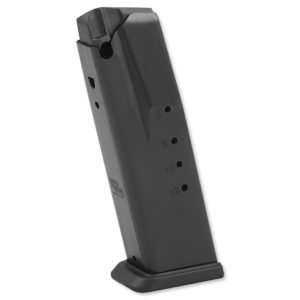
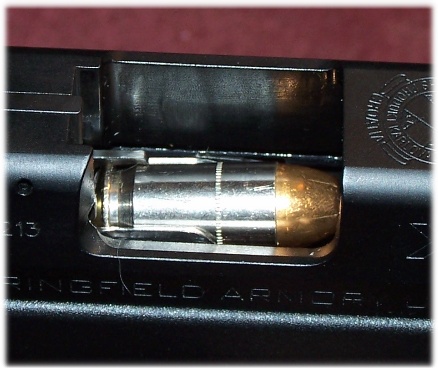
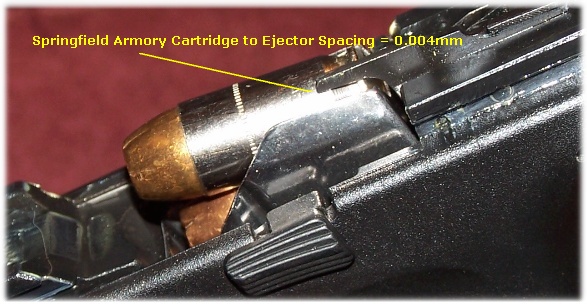

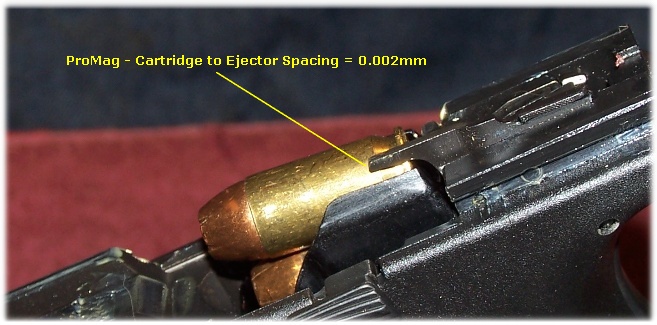
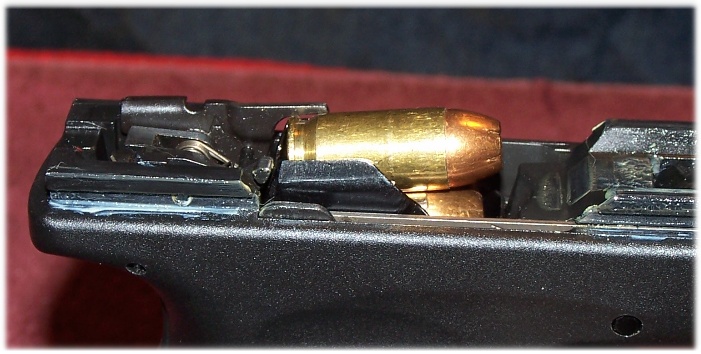
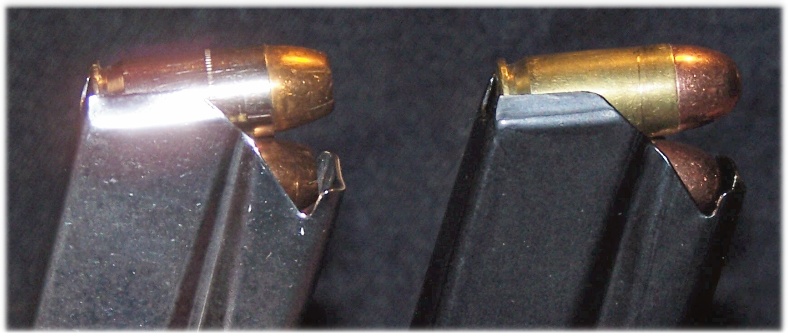

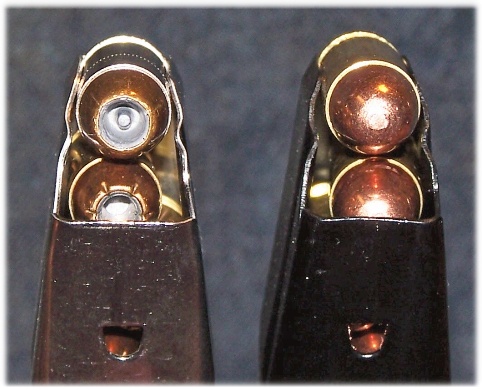

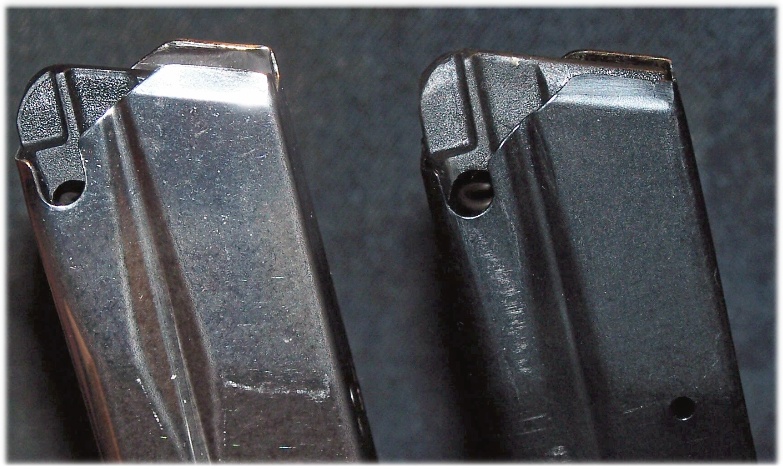
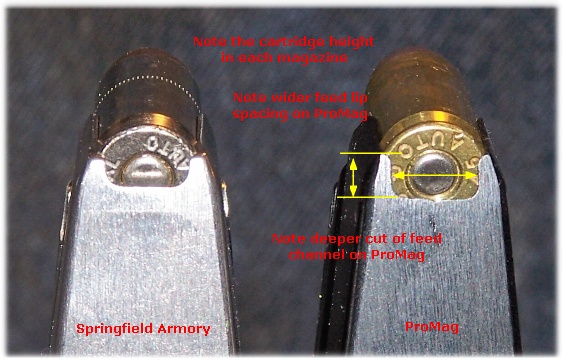
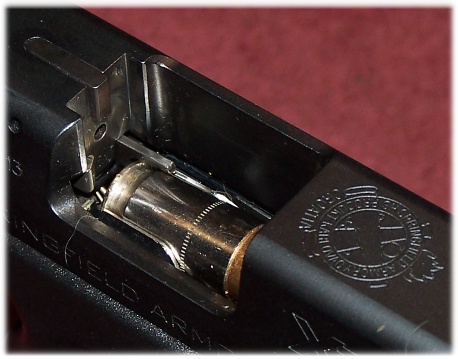

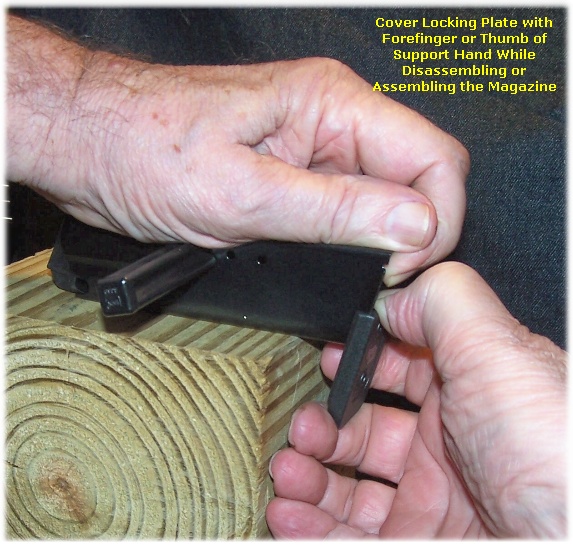
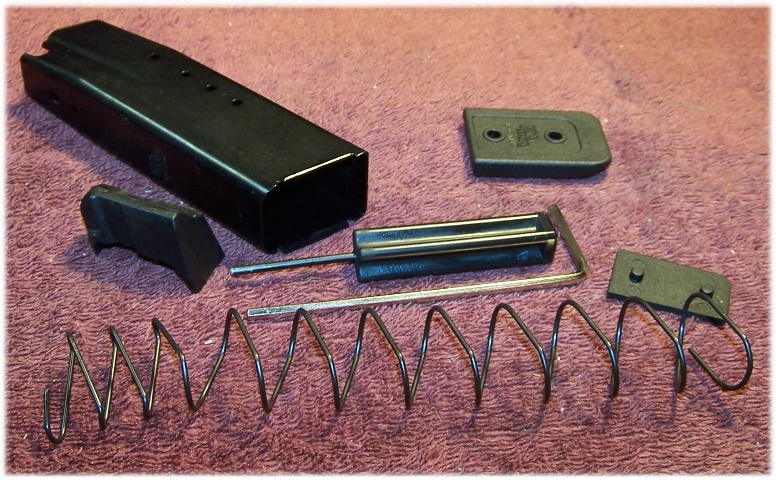
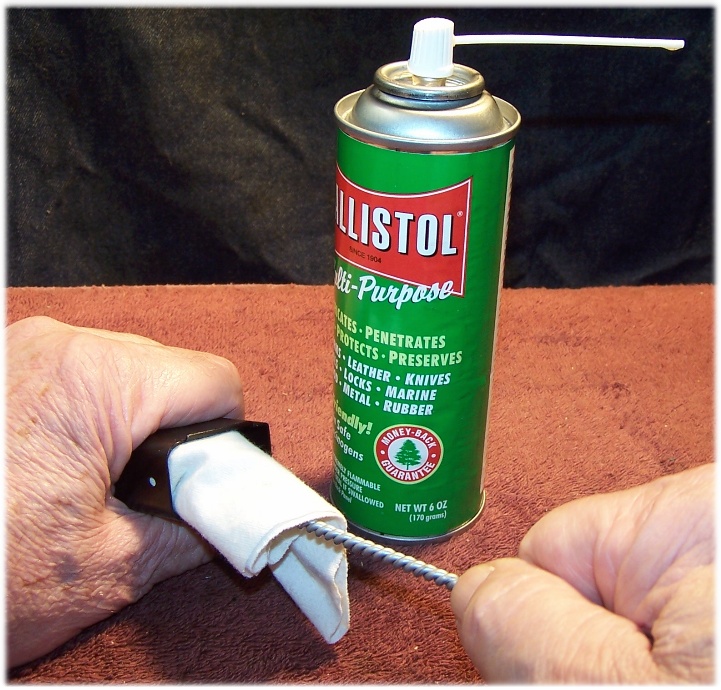
One Response to ProMag Springfield XD/XDM Magazine .45 ACP 13 Round Steel Blued Finish SPR-A8 Is it crap or CRAP?